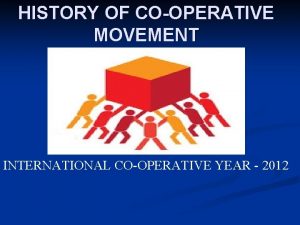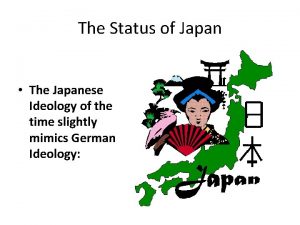Module 1 Cooperative history and ideology principles and






































































- Slides: 70

Module 1: Cooperative history and ideology, principles, and values

Overview 1. 2. 3. 4. 5. 6. 7. 8. 9. 10. What is a cooperative? History, identity, values and principles Values and principles of the Cooperative group in UK – a case Different types of cooperatives Cooperatives in Europe – Facts, statistics and general attitudes / obstacles Cooperatives in Finland Cooperatives in Iceland Cooperatives in Italy (Trentino) Cooperatives in Poland Cooperatives in Sweden Future of the cooperative form?

Part 1 What is a cooperative? History, Identity, values and principles

What is a cooperative? Business owned and run by its members Members can be Customers Employees or residents Equal say, equal share in profits Business driven by values Shared, internationally agreed principles Building a better world Sustainable enterprises, generating jobs and prosperity Answers to poverty and short term business practices

Pre-conditions The industrial revolution Late 18 th Century Societal changes From farmer´s societies to big industrial cities) Emergence of big factories Increased use of technique and mechanics Big growth of capital Hard competition Poor conditions of labor workers

Workers’ conditions Men, women and children worked long hours for little pay Competition between factories caused cuts in workers’ salaries High rate of unemployment, no job security Poor living conditions (housing, clothes, food) No cooperation between workers against employers

Origins of the Cooperative Movement 19 th Century Europe Britain and France Livelihood of workers under threat First consumer cooperative founded in Fenwick, East Ayrshire in 1769 Hundreds of cooperatives by 1830 Rochdale Society of Equitable Pioneers establish the Rochdale Principles in 1844 Basis for development and growth of the modern cooperative movement

Why were cooperatives established? Poverty among farmers and the working class in general Difficulty of accessing affordable goods and services Particularly in rural areas Reasons for establishing cooperatives … The need to achieve economy of size Increase bargaining power Share common costs of new technology Add value to agricultural products Gain access to new markets Reduce risks associated with new enterprises Obtain new services Purchase in bulk to achieve lower prices Provide credit under reasonable terms

Cooperative identity , , A co-operative is an autonomous association of persons united voluntarily to meet their common economic, social, and cultural needs and aspirations through a jointly-owned and democratically-controlled enterprise. ” (Source: http: //2012. coop/en/what-co-op/co-operative-identity-values-principles)

Cooperative values Self-help Self-responsibility Democracy Equality Equity Solidarity Honesty Openness Social responsibility Caring for others

1 Voluntary and open membership Principles as guidelines Putting cooperative values into practice Voluntary organizations Open to all for Using the service Accepting responsibilities of membership No gender, social, racial, political or religions discrimination

2 Democratic member control Democratic organisations Members´control Setting policies, making decision Equal voting rights One member, one vote Democratic organization

3 Member economic participation Equitable contribution of members Democratic control Common capital Limited compensation of members Purposes Developing the cooperative Benefitting members in proportion to their transactions with the cooperative Supporting other acitivities approved by the membership

4 Autonomy and Independence Autonomous, self-help organizations Controlled by members External agreements and capital resources depended on democratic decisions among members

5 Education, Training and Information Providing education and training for Members Elected representatives Managers Employees Purpose: To contribute to the development of the cooperative Informing the general public on nature and benefits of the cooperative Especially young people

6 Co-operation among Co-operatives Effective service for members Strengthen the cooperative movement by cooperation Local structures Regional structures National structures International structures

7 Concern for community Sustainable development of the community through policies approved by members )

Part 2 Values and principles of the Cooperative group in UK – a case

The Co-operative Group UK From a small shop in Lancashire to a worldwide movement 1844: Rochdale pioneers established Rochdale rules

Values of The Co-operative Group Self-help We help people to help themselves Self-responsibility We take responsibility for, and answer to our actions Democracy We give our members a say in the way we run our businesses Equality No matter how much money a member invests in their share account, they still have one vote Equity We carry out our business in a way that is fair and unbiased Solidarity We share interests and common purposes with our members and other cooperatives.

Ethical values of The Co-operative Group Openness Nobody’s perfect, and we won’t hide it when we’re not Honesty We are honest about what we do and the way we do it Social responsibility We encourage people to take responsibility for their own community, and work together to improve it Caring for others We regularly fund charities and local community groups from the profits of our businesses.

The principles of The Co-operative Group. . . . are the way they put their values into action Voluntary and open membership Membership is open to everyone Democratic member control All members have an equal voice in making policies and electing representatives Member economic participation All profits are controlled democratically by members and for their benefit Autonomy and independence Co-operatives are always independent, even when they enter into agreements with the Government and other organisations Education, training and information Co-operatives educate and develop their members as well as their staff Co-operation amongst co-operatives Co-operatives work together with other co‑operatives to strengthen the co-operative movement as a whole Concern for community Co-operatives also work to improve and develop the community, both locally and internationally.

Tackling global climate change through cooperative values and actions One of the largest supporters of renewable energy programs Objective: to be one of world´s leading businesses tackling global climate change Over 5000 branches powered by renewable energy All big businesses report energy consumption and carbon emission

Examples of initiative projects in climate change Installing photovoltaic panels at schools across the UK Building the UK’s largest solar panel project Supporting the construction of six new wind turbines Building the largest in-house office waste-recycling centre in the UK

Part 3 Different types of cooperatives

Consumer cooperatives Providing members with goods and services for their personal use Examples: Food cooperatives Credit unions Housing cooperatives Insurance co-operatives

Producer / marketing cooperatives Marketing their members' products and services directly Some cooperatives may also sell the input necessary to their members' economic activities Examples: Agriculture co-operatives pooling of equipment Advisory services Negotiation of prices with buyers Assembling products into larger quantities to processors, wholesalers and retailers

Worker cooperatives Providing cooperative members with work by operating an enterprise Owned by their employee members Examples: forestry, leisure, production and manufacturing, tourism, communications and marketing, etc. Worker-Shareholder co-operatives Incorporated co-operatives that hold partial ownership of the business in which the co-op's members are employed. Because of its share capital, the co-operative may participate in the management of the business and the workers may influence work organization. Examples: production and manufacturing, technology, etc.

Purchasing and shared service cooperatives Multi-stakeholder cooperatives Membership made of different categories of members who share a common interest in the organization Owned by small independent businesses, municipalities Examples: home care services, health services, community services, etc.

Part 4 Cooperatives in Europe Facts, statistics and general attitudes / obstacles

Cooperatives in Europe 2005 and 2009 Enterprises Members Jobs 2005 256. 742 163 million 5, 4 million 2009 157. 385 123 million 5, 3 million

Paid employment in EU cooperatives 2009 -10 EU member states Employment Austria 61. 999 Belgium 13. 547 Denmark 70. 757 Finalnd 94. 100 France 320. 822 Germany 830. 258 Greece 14. 983 Ireland 43. 328 Italy 1. 128. 381 Luxembourg 1. 933 Portugal 51. 391 Netherlands 184. 053 Spain 646. 397 Sweden 176. 816 United Kingdom 236. 000

Paid cooperative employment in new EU member states 2009 -10 New EU Member States Employment Bulgaria 41. 300 Cyprus 5. 067 Czech Republic 58. 178 Estonia 9. 850 Hungary 85. 862 Latvia 440 Lithuania 8. 971 Malta 250 Poland 400. 000 Romania 34. 373 Slovakia 26. 090 Slovenia 3. 428 Acceding and candidate countries Croatia 3. 565 Iceland 800 (according to Conventus Gap Analysis)

General attitudes twofolded: Positive among people working in the cooperative sector Especially in stronger cooperative areas More sceptical, limited knowledge among others Public authorities acknowledge cooperatives but do not necessarily support cooperative business start-ups Growing interest among young people, politicians and decision makers Exceptions: Poland: unfavourable attitude due to conenction with the communist times

General obstacles for establishing a cooperative Main obstacles: Lack of financing Limited knowledge of co-op as a business format Economic downturns in Europe preventing people from inveistments in new businesses

Coop ‘state fo the art’ in partner countries Conventus Partner Countries FINLAND ICELAND ITALY POLAND SWEDEN Number of inhabitants 5. 375. 276 320. 000 60. 681. 514 38. 000 9. 415. 570 Number of co-op employees 37. 480 800 1. 100. 000 300. 000 63. 000 Number of co-op companies 4. 227 35 43. 000 9. 000 12. 500 Number of co-op federations 9 1 12 62 22 Largest co-op business sectors Retail trade Agriculture Housing Consumer Banking Housing Banking Agriculture Housing Wood Food Social / Dairy Agriculture processing process Consumer Number of individuals for establising 3 Not Depends on 5 (social 3 a cooperative required sector coop), 10 for (min. 15 all other members) Specific law on cooperatives Yes Yes No, but there is a special law for economic assotiations Co-op employees % of inhabitants 0, 7% 0, 3% 1, 8% 1% 0, 7% Average no of employees pr co-op company 9 23 26 33 5

Part 5 Cooperatives in Finland

Historical background Birth of the cooperative movement in Finland in 1900 -1910 Retail cooperatives biggest Contradictory attitudes in 1995 due to resistance from construction workers Cooperatives playing an important role in rural area´s sustainable development

Social effects Big cooperatives important employers and service suppliers in the region Special social role doesn´t exist Employee-owned cooperatives are growing in numbers and creating jobs e. g. for graduate young professionals in areas where sustainable cooperative development is practiced

General attitudes towards cooperatives Varies between different regions Positive in areas which have cooperative development organisations Often not regarded as ‘real’ enterprise Now being accepted as business forms Twofold attitudes: General neutral reaction (SOK, biggest coop market) Service cooperative – little known, challenging role Younger age groups lacking the cooperative spirit (media influences, more individualism) Positive influences – people getting tired of marketing forces Increased emphasis on sustainability of communities Attitudes in comparison with other enterprises Cooperatives considered as ‘ playgrounds’ Operations based on community, non-profit

How can attitudes be altered / changed? Negative attitude linked to ignorance and bad experiences from cooperatives More information could lead to more positive attitudes Increased number of members of existing cooperatives More help from the government Remaking of cooperative laws Establishment of cooperative ´hatcheries´ by the government

Main obstacles for cooperatives Insufficient information of the cooperative as a form of enterprise Demanding and complicated People not aware of the benefits Cooperatives established form in rural areas Committment necessary Lack of team work and interest Lack of good business ideas for cooperatives Lack of identified social need in the society for this form of enterprise

A Cooperative case Pienkoti Akselina Location: Kemi, Lapland Branch: Social and health care Established in 1999 7 owners (6 working with social and health care issues) Annual revenue: 400 000 Euro Producing intensive service of the habitation for elderly people Main goal: Achieving stability and own facilities

Part 6 Cooperatives in Iceland

Historical background 19 th century Iceland Poor society of farmers Poor conditions, little space for agriculture Natural disasters Volcanic eruptions, cold seasons Emigration to USA and Canada Trade monopoly of the Danish Kingdom in Icelanders paid high prices for imported goods and received low prices for their exported goods Danish merchants had all the power regarding prices and many households were high in debts First cooperatives were farmer´s cooperatives, established in 1882 Mixed operations, groceries, dairy productions, butcheries, fisheries etc. – formed the basis in the 20 th century Icelandic economy Collapse of the Icelandic cooperatives in 1980 s

Social effects Very little nowadays In areas where cooperatives are active, they frequently support local sport clubs and cultural events etc.

General attitudes towards cooperatives Negative attitudes in relation to bankrupcy of some of the dominant cooperatives in 1980 s Cooperative managers accused of corruption Negative political debate and connection Following an increased emphasis on privatisation and freemarket capitalism Changes in economic attitudes in relation to the economic collapse in 2008 More positive attitudes towards cooperatives in areas with existing cooperatives Re-evaluation: ‘Back to basics’

How can attitudes be altered / changed? Little public debate on the cooperative form General public unaware of the cooperative ideology and the worldwide use of the form Debate needs to be free of the old political debate Might interest young people who do not remember that debate Introducing the cooperative form, values and principles might interest general public Reviewing the cooperative law More public discussion is needed, without the political connection in the past

Main obstacles for cooperatives General lack of economic investments Low stimulus for investments Negative attitude towards cooperatives Linkage to controvertible businessmen Linkage to certain political movement Lack of renewal in membership in current cooperatives

A cooperative case NPA centre Founded in 2010, 33 founding members One of the youngest cooperatives in Iceland Social cooperative Non-profit in the social and health sector Owned and managed by people with disabilities Purpose To provide personal services and assistance to people with disabilities using direct municipal funding (provided by law) in order to recruit their own staff and influence the assistance they need in everyday life To provide short seminars and courses for disabled people and their family members Assistants work according to job descriptions written by members themselves, according to their needs and wishes

Part 7 Cooperatives in Italy (Trentino)

Historical background Trentino Small area – 2% of Italy (60% above 100 m altitude) Low unemployment rate (3. 6% compared to 8, 5% in Italy in general) 255. ooo members in 536 cooperatives One of the poorest areas in Italy in the 19 th century 1870 -1890: 24. 000 emigrated to America First cooperatives established !890 -1892: First consumer cooperative and cooperative bank established

Social effects Trentino Important role in the socio-economic framework Creation of wealth and employment Supporting the well being of cooperative members and the community Half of inhabitants (500. 000) are members 2, 6 billion Euros in income Cooperatives provide work for 17. 000 people

General attitudes towards cooperatives Trentino Social and cultural movement in close relationship with the community Large proportion of the local economy; 90% agriculture, 55% credit, 38% consumer Resolving and improving welfare of its members and for the community Quite positive attitudes towards cooperatives among the public in Trentino (historical context) In favour beyond other forms of enterprises Strong belief in the origins and traditions, family heritage This region open for this kind of business model Interest of local authorities Public bodies look at cooperative enterprises as SMEs in general Little interest of the local academic world

Main obstacles for cooperatives No particular obstacles for establishing a cooperative in the province of Trentino On contrary, political and socio-economical frameworks favour and support their development

A cooperative case Dinamos (in Trentino) 42 members / owners Annual revenue: 2. 000 Euro Established in 2007, working in the housing branch Personalized solutions for housing needs of the members and their families Vision: To support people in acquiring their first homes Green buildings with economic conditions, natural materials, low environmental impact and energy saving, care of detail, durability of materials used and investment value Respecting social responsibility parameters and methods (strict criteria of transparency, certification and social reporting

Part 8 Cooperatives in Poland

Historical background Rural cooperatives established in the 19 th century First cooperative established in 1816 (for peasants) Agricultural and trade cooperatives, dairy, savings and loans cooperatives established in the 1860 s (oppressed by authorities) Cooperatives associated with communism Post 1948, farmers put under political, administrative and economic pressure to join cooperatives) Abandonments of cooperatives by peasants in 1956 (‘destalinisation’) The state more intervened in cooperative´s production and decision making 1960 – 1989 Post-communism (1990 s) Functioning of cooperatives was abolished and their assets sold below value and the market was opened foreign goods

General attitudes towards cooperatives Unfavourable attitudes due to recent historic heritage connected with the communist times Political powers, mass media, general public (apart from people connected with the cooperative sector Lack of knowledge Disapproval of communal forms in favour of individualism Tendency of generalizing Cooperatives not perceived as an alternative business model, disregarded by the political elites of the countries Diminished number of cooperatives since 1989 Unfavourable law body – giving privileges to commercial companies

Social effects Substantial social infoences 9000 cooperative societies 8 million members 300. 000 employees Members of cooperative societies with their families form almost half of the Polish population Cooperative business model associated with stability and social safety due to cooperative principles which determine democracy, solidarity, self-help, cooperation etc.

How can attitudes be altered / changed? By educating politicians, journalists and the youth on the fact that the cooperative sector on following facts: That cooperatives are not a relic of the old times Cooperatives proved to immune the global crisis Cooperatives important for world wide economies To provide good, stable cooperative legislation To support all initiatives, especially young people setting up new forms of cooperatives, like social cooperatives and forms resembling cooperatives which may contribute to attitude changes

Main obstacles for cooperatives Government´s negative attitude Unfavourable legal conditions Lack of interest of Polish citizens in setting up new cooperatives Negative linkage to controvertible business and certain political movement Lack of renewal in membership

Part 9 Cooperatives in Sweden

Historical background Birth of the Swedish cooperative movement in the 1890 s (following the growth of Sweden´s industrial revolution) Growing working class created in urban areas 1896 -1899: 200 new consumer cooperatives were established

General attitudes towards cooperatives Lack of knowledge of this specific form of enterprise Cooperatives not considered an important part of the economy Considered rare in Sweden, sometimes regarded as an old and outdated way of running a busienss Often confused with voluntary associations Positive attitudes among young people Growing interest among politicians, decision makers and the target group Lack of resources for marketing, limited visibility More visibility is needed People tend to get more positive

Social effects Social enterprises rapidly increasing in number A part of community development New cooperatives in the field of renewable energy (wind power, biogas) New cooperatives in health care, social care, household services Small-scale collaboration in local foods as growing area within the cooperative movement in rural areas, like Skaraborg

Main obstacles for cooperatives Financing Lack of knowledge about the cooperative movement Lack of knowledge of the cooperative as a form of enterprise

A cooperative case Kooperativet Lärkan Social cooperative 36 members, established in 2005 Second hand store, yard work, bike-repair and café Vision: To help as many people as possible to get a fulfilled life and empowerment Everybody is of equal value Everyone deserves and has the right to have good life

Part 10 Future of the cooperative form

The future of cooperative form? Countries and areas where cooperatives or other social economies are substantial were not badly affected by the financial crisis in 2008 The cooperative values and principles may appeal more to the general public after the recession Greater emphasis on sustainable development and social responsibility The social economy growing stronger in traditional sectors, like agricultures, industry, retailing, banking, services and mutual insurance Significant contribution to three main priorities of Europe 2020; smart, sustainable and inclusive growth
 Cooperative ideology
Cooperative ideology Karve committee on cooperative principles
Karve committee on cooperative principles Rochdale cooperative principles
Rochdale cooperative principles Identity q
Identity q C device module module 1
C device module module 1 Ideology examples
Ideology examples Difference between theory and ideology
Difference between theory and ideology Allama iqbal and ideology of pakistan
Allama iqbal and ideology of pakistan Sistemas democraticos
Sistemas democraticos Core ideology and envisioned future
Core ideology and envisioned future Kimitake hiraoka background
Kimitake hiraoka background Masculinity ideology
Masculinity ideology Political ideology ap government
Political ideology ap government Significance of ideology
Significance of ideology What is the ruling class ideology
What is the ruling class ideology Okja definition
Okja definition American collectivism
American collectivism Goth ideology
Goth ideology Collectivism ideology
Collectivism ideology Japan ideology
Japan ideology Hitler ideology
Hitler ideology Ideology
Ideology Machiavelli ideology
Machiavelli ideology Perspectives on ideology
Perspectives on ideology Idealism realism
Idealism realism Political ideology definition
Political ideology definition Whats political ideology
Whats political ideology Horkeimer
Horkeimer Conservative comparative and superlative
Conservative comparative and superlative Ideology
Ideology Marxist ideology
Marxist ideology Political ideology
Political ideology Imperialism essential questions
Imperialism essential questions Definition social stratification
Definition social stratification Myclerk.myorangeclerk.com search
Myclerk.myorangeclerk.com search Political spectrum diagram
Political spectrum diagram Political ideology
Political ideology What is ideology
What is ideology Ideology meaning
Ideology meaning Standard language ideology
Standard language ideology Asgardsrei metallum
Asgardsrei metallum Great musthaves
Great musthaves What is ideology
What is ideology First person shooter ideology
First person shooter ideology Integrasi menurut paulus wirutomo
Integrasi menurut paulus wirutomo Principles of marketing module 9
Principles of marketing module 9 Factors influencing consumer buying decision
Factors influencing consumer buying decision Principles of marketing module 6 answer key
Principles of marketing module 6 answer key Business ethics and social responsibility module 5
Business ethics and social responsibility module 5 Principles of marketing grade 11 module 2 answer key
Principles of marketing grade 11 module 2 answer key Principles of marketing module 10
Principles of marketing module 10 Principles of marketing module 8
Principles of marketing module 8 Early management
Early management Salvation history in the old testament
Salvation history in the old testament Management history module
Management history module Climbs insurance history
Climbs insurance history This type of work
This type of work Iphil savings and credit cooperative
Iphil savings and credit cooperative What is crr in accounting
What is crr in accounting Ohio valley educational cooperative
Ohio valley educational cooperative Cooperative model example
Cooperative model example Cooperative vs collaborative learning
Cooperative vs collaborative learning Tgt cooperative learning
Tgt cooperative learning Definition of social learning
Definition of social learning Cooperative governance
Cooperative governance Cooperative learning ideatore
Cooperative learning ideatore Maxim of quanlity
Maxim of quanlity Cooperative thread array
Cooperative thread array Think pair share cooperative learning
Think pair share cooperative learning Write a short note on industrial estate
Write a short note on industrial estate Cooperative learning pies
Cooperative learning pies


























































































